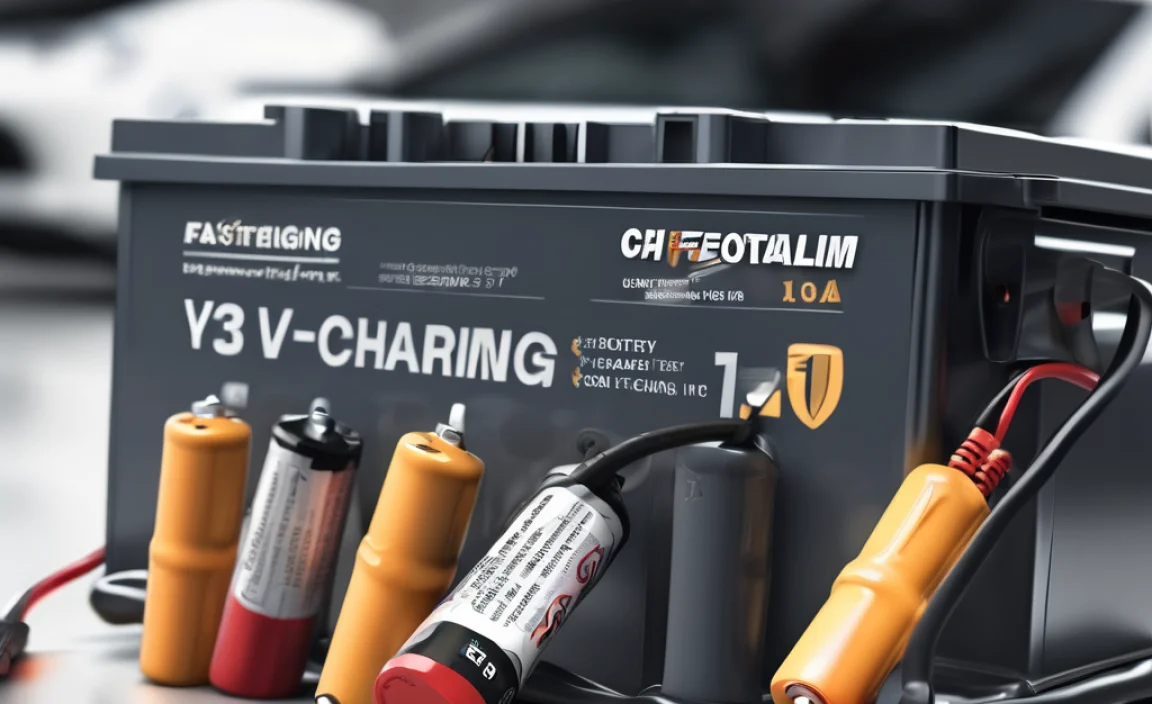Quick Summary
Finding the right battery for your PetSafe shock collar is crucial for ensuring its reliable performance and your pet’s safety. This guide covers selecting compatible batteries, understanding battery life, and simple maintenance tips to keep your collar powered up and your dog happy.
Battery For PetSafe Shock Collar: Essential Power for Your Canine Companion
Is your PetSafe shock collar’s battery giving up at the worst possible moment? It’s a common frustration when the indicator light starts blinking, or worse, goes dark right when you need it most. Keeping your dog’s training collar powered up is essential for safety, consistency, and peace of mind.
Don’t worry, this isn’t rocket science! Roy Walker is here to make understanding your PetSafe shock collar battery simple. We’ll walk through how to pick the right power source, what to expect in terms of battery life, and some easy ways to keep it working its best. Let’s make sure your furry friend stays safe and happy, with a collar that’s always ready to go.
Understanding Your PetSafe Shock Collar Battery Needs
PetSafe offers a range of electronic training collars, and each model often has specific battery requirements. It’s like choosing the right size shoe for your dog – it needs to fit just right to work properly. Using the wrong battery can lead to poor performance, or even damage to your collar.
The most common types of batteries you’ll encounter for PetSafe collars are:
- Lithium-ion (Li-ion) batteries: These are often rechargeable and can be found in newer, more advanced models. They offer good power density and a longer lifespan.
- Lithium (primary cell) batteries: These are non-rechargeable, often coin-cell or cylindrical batteries, common in older or simpler models. They are convenient for their long shelf life and instant use but need replacement once depleted.
Always check your PetSafe collar’s manual or the collar itself for the exact battery type and size your model requires. This information is usually printed near the battery compartment.
The Importance of the Right Battery Type
Why does the battery type matter so much? Different batteries provide different voltages and amperages. Your collar is designed to operate within a specific range. Putting in a battery with the wrong specifications can:
- Cause the collar to not work at all.
- Lead to inconsistent correction levels.
- Potentially overheat and damage the collar’s electronics.
- Reduce the overall lifespan of the collar.
Think of it like trying to power a small radio with a car battery – it’s just too much power and the wrong kind! For your PetSafe collar, sticking to the recommended battery type ensures optimal performance and longevity. For more in-depth information on battery technologies, you can explore resources from the U.S. Department of Energy, which provides excellent, easy-to-understand explanations of various battery types.
Choosing the Best Battery for Your PetSafe Shock Collar
When it’s time to buy a new battery, you have a few options. It’s important to prioritize quality and compatibility to ensure your collar functions as intended. Here’s how to make a smart choice:
Option 1: Official PetSafe Replacement Batteries
This is almost always the safest and most straightforward option. PetSafe manufactures their own batteries or works with specific suppliers to ensure their products meet exact specifications. These batteries are guaranteed to be compatible with your collar model.
Pros:
- Guaranteed compatibility.
- Designed for your specific collar model.
- Often come with a warranty or direct support from PetSafe.
Cons:
- Can sometimes be more expensive than third-party options.
- Availability might be limited to PetSafe’s website or authorized retailers.
Option 2: High-Quality Third-Party Batteries
Many reputable brands offer batteries that are compatible with PetSafe collars. These can be a good alternative if you’re looking for more purchasing options or potentially better pricing. However, not all third-party brands are created equal.
What to look for in a third-party battery:
- Brand Reputation: Stick with well-known battery manufacturers that have a reputation for quality and reliability.
- Exact Specifications: Double-check that the voltage, capacity (mAh), and physical dimensions match what your collar requires.
- Customer Reviews: Read reviews from other PetSafe collar users to see their experiences.
- Warranty: Look for brands that offer a decent warranty on their batteries.
Pros:
- Potentially more affordable.
- Wider availability at various retailers.
- More brand choices.
Cons:
- Risk of incompatibility if specifications aren’t matched precisely.
- Quality can vary significantly between brands.
- May not have the same lifespan or performance as official batteries.
Pro Tip: Always compare battery specifications carefully. A simple image search for your collar model’s battery type can often help you verify what you need.
Battery Performance: What to Expect
How long a battery lasts depends on several factors, including the type of battery, the collar model, and how often it’s used. For rechargeable batteries, the number of charging cycles is also a key consideration.
Factors affecting battery life:
- Usage Frequency: A collar used daily for long training sessions will drain the battery faster than one used sporadically.
- Correction Intensity: Higher-level stimulation settings use more power than lower ones.
- Signal Strength/Range: If the collar needs to maintain a strong signal over a longer distance or through obstacles, it can consume more battery.
- Battery Health: Like all batteries, rechargeable ones degrade over time and will hold less charge after many cycles.
Most PetSafe rechargeable collars offer a visual indicator for battery life, often a blinking light that turns red or a specific pattern. For non-rechargeable batteries, you generally get a consistent performance until they are depleted.
Replacing the Battery in Your PetSafe Shock Collar: A Step-by-Step Guide
Replacing the battery in your PetSafe shock collar is usually a straightforward process. Always refer to your specific collar’s manual, as designs can vary slightly. Here’s a general guide that covers most models:
Tools You Might Need:
- The correct replacement battery.
- A small Phillips head screwdriver (if the battery compartment is screwed shut).
- A clean, dry cloth.
- Your PetSafe collar’s user manual.
Steps for Battery Replacement:
- Power Down the Collar: Before attempting to replace the battery, ensure the collar is turned OFF. This prevents any accidental activation and protects the electronics.
- Locate the Battery Compartment: The battery compartment is usually found on the underside of the collar receiver unit. It might be covered by a small door, a plate, or a cap.
- Open the Compartment:
- If it’s a door, gently pry it open with your fingernail or a small, non-metallic tool.
- If it’s a compartment secured by screws, carefully unscrew them using the appropriate screwdriver. Keep the screws in a safe place so you don’t lose them!
- Remove the Old Battery:
- If it’s a coin cell, you might be able to gently pry it out with your fingernail or a plastic tool. Avoid using metal screwdrivers directly on the battery contacts if possible, to prevent shorting.
- If it’s a cylindrical or pack battery, it might just pull straight out, or it could have a small clip or tab to release.
- Insert the New Battery:
- Pay close attention to the orientation of the battery. Most batteries have a ‘+’ and ‘-‘ marking, and the compartment will have corresponding markings or indentations to ensure correct placement.
- For rechargeable batteries, ensure they are seated correctly in their charging cradle if they are removable units.
- Close the Compartment:
- If you removed screws, reinsert and tighten them carefully. Don’t overtighten them, as this could strip the threads or crack the plastic.
- Snap the battery door or cap back into place until it clicks securely. Ensure it’s sealed properly to prevent moisture from entering.
- Test the Collar: Turn the collar back ON. Check for a power indicator light. If it’s a rechargeable battery, place it on its charger according to the manual’s instructions. If it’s a brand new primary cell battery, it should power on immediately and be ready for use.
Safety Note: Never use damaged batteries (leaking, corroded, or swollen). Properly dispose of old batteries according to local regulations. Battery disposal guidelines can often be found on your local government’s waste management website.
Battery Maintenance for Longevity
Keeping your PetSafe shock collar battery in good condition can extend its life and ensure consistent performance. Just like you’d care for your phone or power bank, a little maintenance goes a long way.
Tips for Maintaining Rechargeable Batteries:
- Avoid Complete Drain: Try not to let rechargeable batteries drain completely on a regular basis. It’s often better to recharge them when the low battery indicator appears.
- Charge Properly: Always use the charger recommended by PetSafe. Charging with an incompatible charger can damage the battery or the collar.
- Store Safely: If you’re storing the collar for an extended period, partially charge the battery (around 50-60%) rather than leaving it fully charged or completely depleted. Store it in a cool, dry place.
- Clean Contacts: Occasionally, gently clean the battery contacts (both on the battery and in the collar) with a soft, dry cloth or a pencil eraser. This ensures a good electrical connection.
Tips for Maintaining Non-Rechargeable Batteries:
- Remove When Storing Long-Term: If you won’t be using the collar for a month or more, remove the batteries. This prevents potential leakage that could damage the collar.
- Store Batteries Separately: Store unused batteries in their original packaging in a cool, dry place. This protects them from moisture and accidental short circuits.
- Check for Corrosion: Before inserting new batteries, check the battery compartment for any signs of corrosion or residue. Clean it gently with a dry cloth or cotton swab if necessary.
Troubleshooting Common Battery Issues
Even with the best care, you might encounter a few battery-related hiccups. Here’s how to tackle them:
Collar Not Turning On:
- Check Battery Installation: Ensure the battery is inserted correctly, with the positive (+) and negative (-) terminals facing the right way.
- Try a Known Good Battery: If possible, try a different brand-new, correctly specified battery to rule out a faulty new battery.
- Clean Contacts: As mentioned, dirty contacts can prevent power flow.
- Battery Depleted: For rechargeable batteries, ensure they are fully charged. For primary cells, they may simply be dead.
Collar Dies Quickly:
- Battery Age (Rechargeable): Rechargeable batteries have a limited lifespan. If your battery is several years old, it may no longer hold a full charge. It might be time for a replacement.
- Increased Usage: Have you recently increased your training sessions or the intensity of stimulation? This will naturally drain the battery faster.
- Faulty Battery: Even new batteries can sometimes be defective. If a new battery drains unusually fast, try another one.
- Collar Issue: In rare cases, a faulty collar might be draining the battery excessively.
Low Battery Indicator Always On (Even with New Battery):
- Incorrect Battery Type/Voltage: Double-check that you’re using the exact battery specified for your collar. An under-voltage battery might trigger the low indicator prematurely.
- Faulty Indicator Circuitry: This could indicate an issue with the collar itself. Contact PetSafe support.
If troubleshooting doesn’t solve the problem, it’s always a good idea to consult your PetSafe user manual or contact PetSafe customer support. They can offer model-specific advice or help determine if the collar itself needs servicing.
Battery Types Compared: A Quick Reference
Here’s a handy table to help you visualize the differences between common battery types you might encounter for electronics like your PetSafe collar.
| Feature | Rechargeable Lithium-ion (Li-ion) | Primary Cell Lithium (e.g., CR2032) | Alkaline (common in older electronics) |
|---|---|---|---|
| Rechargeable | Yes | No | No |
| Typical Use Case | Modern collars, electronics needing frequent power | Small, low-drain devices, backup power | Toys, remote controls, low-drain devices |
| Energy Density | High | High | Moderate |
| Lifespan (Cycles for Rechargeable) | Hundreds to thousands | N/A | N/A |
| Shelf Life | Good (holds charge well) | Excellent (years) | Moderate (a few years) |
| Cost | Higher initial cost, lower per-use cost | Moderate | Low |
| Environmental Impact | Lower over lifetime (reusable), but manufacturing impact | Discarded after use | Discarded after use |
This table highlights why rechargeable Li-ion batteries are very popular for modern devices like many PetSafe collars. While they cost more upfront, their ability to be recharged hundreds or thousands of times makes them very economical and environmentally friendly in the long run.
Frequently Asked Questions (FAQs)
Q1: How often should I replace the battery in my PetSafe shock collar?
A: For rechargeable batteries, they don’t need “replacement” in the traditional sense until they can no longer hold a sufficient charge, which typically happens after several years of use (hundreds to thousands of charge cycles). For non-rechargeable batteries, you should replace them as soon as they are depleted, or if you notice any performance issues.
Q2: Can I use a generic battery instead of a PetSafe-branded one?
A: Yes, you can, but it’s crucial to ensure the generic battery has the exact same specifications (voltage, capacity, size) as the one recommended by PetSafe. Using a battery with different specifications can cause performance issues or damage the collar.
Q3: My PetSafe collar isn’t powering on after replacing the battery. What should I do?
A: First, double-check that the new battery is inserted correctly, paying close attention to the positive (+) and negative (-) terminals. If it’s a rechargeable battery, ensure it’s fully charged. Also, check that the battery contacts inside the collar are clean.
Q4: How do I know if my PetSafe rechargeable collar battery needs replacing?
A: You’ll notice that the battery doesn’t hold a charge for as long as it used to, even after a full charging cycle. It might drain much faster during use or may not power the collar for a full training session. This indicates it’s time to consider a replacement.
Q5: Where can I safely dispose of old PetSafe shock collar batteries?
A: Old batteries should never be thrown in the regular trash. Rechargeable batteries and lithium batteries often contain hazardous materials. You can typically take them to electronic waste recycling centers, special battery collection points (often found at electronics stores or government facilities), or check with your local waste management services for proper disposal instructions.
Q6: What does the blinking light on my PetSafe collar usually mean regarding the battery?
A: A blinking light, especially a red one, usually indicates a low battery. However, PetSafe collar indicator lights can have different meanings depending on the model (e.g., charging status, low battery, or activation). Always refer to your specific collar’s manual for an accurate explanation of its indicator light patterns.
Conclusion: Keeping Your Canine Connected and Safe
Your relationship with your dog is built on trust and clear communication, and a well-functioning PetSafe shock collar plays a vital role in that for many owners. Understanding the right battery for your collar isn’t just about convenience;



